
Higher education in Alberta
Encyclopedia
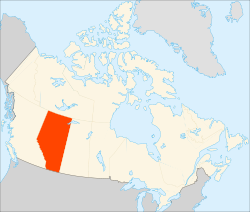
Alberta
Alberta is a province of Canada. It had an estimated population of 3.7 million in 2010 making it the most populous of Canada's three prairie provinces...
. The Ministry of Advanced Education & Technology in Alberta oversees educational delivery through universities, publicly funded colleges, technical institutions, and private colleges. These institutions offer a variety of academic and vocational pursuits. Students have access to post-secondary options through most regions of Alberta, and a developed articulation
Articulation (education)
In Australia and United States education, articulation or more specifically course articulation, refers to the process of comparing the content of courses that are transferred between postsecondary institutions such as TAFE institutes, colleges or universities...
system allows for increased student mobility.
History
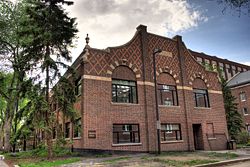
Establishment of universities in Alberta (1908-1950s)
In 1905, the province of AlbertaAlberta
Alberta is a province of Canada. It had an estimated population of 3.7 million in 2010 making it the most populous of Canada's three prairie provinces...
was created out of the North West Territories and the following year, the Alberta legislature passed an act to establish a provincial university. Founded in 1908, the University of Alberta
University of Alberta
The University of Alberta is a public research university located in Edmonton, Alberta, Canada. Founded in 1908 by Alexander Cameron Rutherford, the first premier of Alberta and Henry Marshall Tory, its first president, it is widely recognized as one of the best universities in Canada...
became the first degree granting institution in the province. The university followed the model of the land-grant state colleges in the Midwest of the United States and is a non-denominational, publicly supported institution that provides programs accessible to the provincial population.
A number of Calgary
Calgary
Calgary is a city in the Province of Alberta, Canada. It is located in the south of the province, in an area of foothills and prairie, approximately east of the front ranges of the Canadian Rockies...
business owners and the municipal government attempted to establish the private "University of Calgary" in Calgary and by October 1912, began classes. In 1911, 1913 and 1915 it applied for degree-granting powers, but was turned down. It was renamed Calgary College, and closed in 1915 due to low enrollment, lack of financial support, continuing squabbles with the province and the beginning of the World War I
World War I
World War I , which was predominantly called the World War or the Great War from its occurrence until 1939, and the First World War or World War I thereafter, was a major war centred in Europe that began on 28 July 1914 and lasted until 11 November 1918...
.
In 1916 The Provincial Institute of Technology and Art (PITA) is established in Calgary to train returning veterans of World War I
World War I
World War I , which was predominantly called the World War or the Great War from its occurrence until 1939, and the First World War or World War I thereafter, was a major war centred in Europe that began on 28 July 1914 and lasted until 11 November 1918...
.
Mount Royal College
Mount Royal College
Mount Royal University is a public university in Calgary, Alberta, Canada. Founded in 1910 as a primary and secondary school, Mount Royal became a post-secondary institution in 1931 as Mount Royal College offering transfer courses to the University of Alberta and later to the University of Calgary...
in Calgary becomes a junior college affiliated with the University of Alberta
University of Alberta
The University of Alberta is a public research university located in Edmonton, Alberta, Canada. Founded in 1908 by Alexander Cameron Rutherford, the first premier of Alberta and Henry Marshall Tory, its first president, it is widely recognized as one of the best universities in Canada...
in 1931 and begins offering one-year university transfer programs. But the affiliation entailed a certain degree of control over college affairs by the University of Alberta.
In 1933, the Banff School of Fine Arts was established with the aid of a grant from the Carnegie Corporation of New York.
After the World War II
World War II
World War II, or the Second World War , was a global conflict lasting from 1939 to 1945, involving most of the world's nations—including all of the great powers—eventually forming two opposing military alliances: the Allies and the Axis...
, higher education in Alberta expanded resulting from the province's fast transformation into an urban industrial society and increased demand for skilled manpower. In response to the growing demand for university education, the provincial government allowed the university of Alberta to establish a branch of its Faculty of Education in Calgary in 1945. In 1957, Lethbridge Junior College was established.
Post-secondary expansion (1960s)
The 1960s was also a period of important institutional development for the post-secondary sector, as various legislations were enacted in order to consolidate and solidify new institutions. Several institutions were created in smaller urban centres, establishing a network of colleges and technical institutes. Some of these were Red Deer CollegeRed Deer College
Red Deer College is a public comprehensive community college of approximately 7,000 students located in Red Deer, Alberta, Canada. Established in 1964, RDC was built for a smaller semi-rural community but, in the four and a half decades since its founding, the city has grown into the third largest...
in 1964, Medicine Hat College
Medicine Hat College
Medicine Hat College is a public, board governed, comprehensive community college serving a large region of southeastern Alberta and southwestern Saskatchewan, Canada....
in 1966, Grande Prairie Junior College
Grande Prairie Regional College
Grande Prairie Regional College, often abbreviated GPRC, is a comprehensive community college with two campuses Grande Prairie and Fairview, Alberta. Over 2,000 students in credit programs, and over 6,000 in workforce training and recreational programs, attend GPRC and Fairview College Campus...
in 1966, and Mount Royal College
Mount Royal College
Mount Royal University is a public university in Calgary, Alberta, Canada. Founded in 1910 as a primary and secondary school, Mount Royal became a post-secondary institution in 1931 as Mount Royal College offering transfer courses to the University of Alberta and later to the University of Calgary...
in 1966. The University of Calgary
University of Calgary
The University of Calgary is a public research university located in Calgary, Alberta, Canada. Founded in 1966 the U of C is composed of 14 faculties and more than 85 research institutes and centres.More than 25,000 undergraduate and 5,500 graduate students are currently...
and the University of Lethbridge
University of Lethbridge
The University of Lethbridge is a publicly-funded comprehensive academic and research university, founded in the liberal education tradition, located in Lethbridge, Alberta, Canada, with two other urban campuses in Calgary and Edmonton. The main building sits among the coulees on the west side of...
, which had been branch campuses of the University of Alberta, were developed into autonomous institutions in 1966 and 1967 respectively.
Federal government support for technical education continued after World War II
World War II
World War II, or the Second World War , was a global conflict lasting from 1939 to 1945, involving most of the world's nations—including all of the great powers—eventually forming two opposing military alliances: the Allies and the Axis...
via the Technical and Vocational Training Assistance Act (TVTAA) of 1960, which was designed to help construct new vocational high schools, institutes of technology and adult-training centres. The province began expanding the capacity for apprenticeship and vocational training that, until then, had been handled solely by the Provincial Institute of Technology and Arts (PITA) in Calgary. The Northern Alberta Institute of Technology
Northern Alberta Institute of Technology
The Northern Alberta Institute of Technology is located in Edmonton, Alberta, Canada and provides technical training and applied education designed to meet the demands of Alberta's industries...
(NAIT) was created in Edmonton
Edmonton
Edmonton is the capital of the Canadian province of Alberta and is the province's second-largest city. Edmonton is located on the North Saskatchewan River and is the centre of the Edmonton Capital Region, which is surrounded by the central region of the province.The city and its census...
, and PITA was transformed into the Southern Alberta Institute of Technology
Southern Alberta Institute of Technology
-Academics:SAIT Polytechnic offers two full baccalaureate degrees , four applied degrees, 66 diploma and certificate programs, 32 apprenticeship trades and 1,600 continuing education and corporate training courses....
, both in 1962.
New agencies were also formed such as the Board of Post-Secondary Education and the Alberta Department of Advanced Education in 1967, which were to oversee post-secondary institutions other than universities. Another milestone occurred in 1966, when the Province of Alberta began systematically providing operating grants to post-secondary institutions. In 1969, the Colleges Act was passed, making colleges partners in higher education in the province. The act aims at solidifying the newly created colleges of the province.
In 1969 the Minister of Education, Robert Curtis Clark
Robert Curtis Clark
Robert "Bob" Curtis Clark is a former teacher, civil servant and provincial level politician. He served as a member of the Legislative Assembly of Alberta from 1960 to 1981. During his career he served as Leader of the Alberta Social Credit Party and Leader of the Official Opposition...
, established a Commission on Educational Planning headed by Dr. Walter Worth. The Worth Report (1972) set the course for PSE in the province to this day. Among the recommendations made in the Worth Report, one major theme is that the provincial government should change structures in such as manner as to have more direct influence on the post-secondary system.
Distance education in Alberta (1970s)
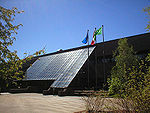
Athabasca University
Athabasca University is a Canadian university in Athabasca, Alberta. It is an accredited research institution which also offers distance education courses and programs. Courses are offered primarily in English with some French offerings. Each year, 32,000 students attend the university. It offers...
in 1970 by an order in council of the Government of Alberta. It was to be the fourth campus-based university in Alberta, but given decreasing enrollments, the institution followed the model of the British open university specializing in the delivery of distance education courses and programs. In 1970, the Alberta government also established the Banff Centre for Continuing Education
Banff Centre
The Banff Centre, formerly known as The Banff Centre for Continuing Education, is an arts, cultural, and educational institution and conference complex located in Banff, Alberta...
under the trustee of the University of Calgary.
The Ministry of Advanced Education
Ministry of Advanced Education
Alberta Advanced Education and Technology is a ministry in the Executive Council of the Canadian province of Alberta. The ministry is usually responsible for all post-secondary institutions in their respective jurisdictions.-External links:* *...
was established in 1972. The Alberta Council on Admissions and Transfer
Alberta Council on Admissions and Transfer
The Alberta Council on Admissions and Transfer is an independent body created in 1974 to facilitate transfer agreements between the various post secondary institutions in Alberta. The vision of ACAT is to "develop a nationally and internationally recognized transfer system" by facilitating the...
(ACAT) was established in 1974 to guide the transfer of academic credit among provincial post-secondary institutions. In 1975, the Conservative government acknowledged the linkage between education and employment by transferring the Manpower Division from Manpower and Labour to the Department of Advanced Education and Manpower. This arrangement existed until 1983, when the manpower portfolio was again separated from Advanced Education.
A series of new funding policies were introduced in 1973 and 1976. These new funding mechanisms took into account factors such as the projection of operational costs over a three-year period and the rate of inflation to determine the allocation of resources for a growing number of institutions.
Increasing institutional competition and financial restructuring (1980s - 1990s)

The 1990s saw Alberta's post-secondary system change in terms of significant financial restructuring imposed by the provincial government, and the introduction of a new and targeted funding model that emphasizes accountability and demonstration of results. These developments were part of the province’s deficit reduction strategy in the Alberta government's 1993 announcement to eliminate its provincial debt within four years. The 1990s were characterized by the introduction of funding caps and reduction in overall support for post-secondary programs. One such program was a tuition fee policy introduced by the provincial government in 1990-91, which limited the amount of revenue that public post-secondary institutions could generate from fees to 30% of net operating expenditures by the year 2000. As a result, Alberta went from being the province with the highest per-capita funding for post-secondary education in 1984 to being the ninth, or second to last in 2000.
Second post-secondary expansion and government restructuring (2000s - present)
In 2000, the provincial government created a K-16 model by combining K-12 and higher education into one department named Alberta Learning.On March 17, 2004, the Post-Secondary Learning Act was proclaimed, amalgamating the former Universities Act, Colleges Act, Banff Centre Act and Technical Institutes Act into a single piece of legislation.
The booming Alberta economy led to significant investments in post-secondary institutions and policies. A series of new scholarships were introduced for all newborns in the province, and the existing Rutherford scholarships were expended. There were also heavy capital investments, with almost all the main campuses receiving funds for expansions, renovations, and upgrades. A new interest in P3 funding also fuelled this expansion. Many of the new facilities and faculty have made the University of Alberta
University of Alberta
The University of Alberta is a public research university located in Edmonton, Alberta, Canada. Founded in 1908 by Alexander Cameron Rutherford, the first premier of Alberta and Henry Marshall Tory, its first president, it is widely recognized as one of the best universities in Canada...
one of the world's top research institutions, and boast the second-largest student body in Canada as of September, 2009.
In September, 2009, Calgary's Mount Royal University and Edmonton's Grant MacEwan University became the province's fifth and sixth public universities, respectively. Formerly considered colleges, both institutions offer many of the degrees and facilities previously only available at the two larger universities.
Despite recent high provincial spending, tuition costs remain a concern for many Alberta students. Many promised cuts have yet to be realized, and costs are expected to rise again in the 2010s. The recent worldwide economic downturn has also brought a huge number of unemployed people back to school, putting further pressures on the institutions.
Geographical
Post-Secondary institutions in Alberta have been established in response to geographic population growth. In the beginning, there was only one university in the province, but satellite campuses were established as the population in other parts of the province grew. Later, these satellite campuses became universities that met the educational needs of the province’s growing urban centres. In the 1960s, colleges sprouted, enabling access to higher education in rural areas.Transferability
Improving access is done not only through geography expansion but also by increasing transferability or articulation of courses and programs between post-secondary institutions. Historically, students completed programs at a single institution. However, over time students have become increasingly mobile, attending more than one post-secondary institution throughout the course of their academic lives. The province has supported and encouraged this kind of student mobility by developing college programs that transfer to larger urban post-secondary institutions where degrees can be completed.Initially articulation between the post-secondary institutions was conducted on a course by course basis. This approach proved to be laborious and inconsistent. As a result, Alberta post-secondary institutions and the provincial government collaborated to establish the Alberta Council on Admissions and Transfer
Alberta Council on Admissions and Transfer
The Alberta Council on Admissions and Transfer is an independent body created in 1974 to facilitate transfer agreements between the various post secondary institutions in Alberta. The vision of ACAT is to "develop a nationally and internationally recognized transfer system" by facilitating the...
(ACAT) in 1974.
Through ACAT, post-secondary stakeholders work cooperatively to ensure a smooth transition and transferability of courses and programs within the post-secondary system. ACAT also promotes assessment and recognition of prior learning assessment to recognize experiences outside of formal course requirements.
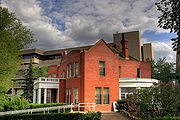
Credit transfer between institutions considers transferability at an individual course level. In some cases, a course may be considered the same at the sending institution as it is at the receiving institution (the course is a transfer course). In other cases, a course is considered sufficiently similar or meets discipline requirements even though there is not an equivalent course at the receiving institution (the course is considered transferable).
In addition to covering Alberta institutions, Aurora College
Aurora College
Aurora College, formerly Arctic College, is a college in the Northwest Territories, Canada with campuses in Inuvik, Fort Smith and Yellowknife. They have learning centres in 23 communities in the NWT. The head office for Aurora College is located in Fort Smith.-Mission:*Aurora College is dedicated...
in Northwest Territories
Northwest Territories
The Northwest Territories is a federal territory of Canada.Located in northern Canada, the territory borders Canada's two other territories, Yukon to the west and Nunavut to the east, and three provinces: British Columbia to the southwest, and Alberta and Saskatchewan to the south...
, and Nunavut Arctic College
Nunavut Arctic College
Nunavut Arctic College is a Crown corporation that is funded by the Government of Nunavut and has several campuses and centres spread out throughout Nunavut, Canada.-History:...
in Nunavut
Nunavut
Nunavut is the largest and newest federal territory of Canada; it was separated officially from the Northwest Territories on April 1, 1999, via the Nunavut Act and the Nunavut Land Claims Agreement Act, though the actual boundaries had been established in 1993...
are covered by ACAT.
In 2007, ACAT and the British Columbia Council on Admissions and Transfer agreed to a protocol regarding transfers between Alberta and British Columbia
British Columbia
British Columbia is the westernmost of Canada's provinces and is known for its natural beauty, as reflected in its Latin motto, Splendor sine occasu . Its name was chosen by Queen Victoria in 1858...
. The purpose of the protocol is to ensure that any student who satisfactorily completes course work in either Alberta or British Columbia, and wishes to transfer to an institution in the other may do so. This protocol is "in lieu of formal articulation because it is unlikely that the volume of students transferring to institutions in the other province will justify the resources necessary to undertake a formal articulation on a course-to-course basis."
Prior Learning Assessment and Recognition - PLAR
Many Alberta post-secondary programs have Prior Learning Assessment and Recognition (PLAR). PLAR recognizes learning can be obtained through means other than formal credit courses.PLAR was in place prior to the change in the post-secondary act and is available in a wide variety of courses and programs. It continues to be a factor that aids in making post-secondary options accessible.
Future challenges and improving access
Changing demographics in Alberta are likely to have a profound effect on post-secondary education. The majority of the population growth in Alberta is its urban centres - Edmonton, Calgary, and Lethbridge - while the proportion of people living in small towns and rural areas is declining. Institutions based in rural communities will likely have challenges meeting enrollment targets while institution in urban centres will face pressure in having enough capacity.Meanwhile, although the number of people immigrating to Alberta has been increasing, persistent gaps between immigrant and non-immigrant Albertans’ success in the labor market will impact the province’s ability to attract and retain highly skilled individuals. Therefore, addressing the most challenging labor market barriers for new Canadians—the lack of Canadian work experience, the lack of recognition for foreign credentials, and language barriers—would support new Albertans and the province in meeting our current and future demographic, labor, and skill needs.
With their Business Plan priorities, the Ministry of Advanced Education
Ministry of Advanced Education
Alberta Advanced Education and Technology is a ministry in the Executive Council of the Canadian province of Alberta. The ministry is usually responsible for all post-secondary institutions in their respective jurisdictions.-External links:* *...
indicates that it is committed to increasing access to learning opportunities. One of their focuses is to target under-represented groups in post-secondary, most notably First Nations, Metis and Inuit learners. The Access Advisory Council is a body appointed by the Ministry of Advance Education and Technology to provide advice in relation to the operation and reporting of the Access to the Future Fund.
Public post-secondary institutional structure

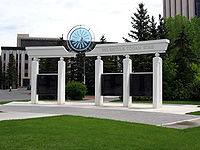
- 1. Comprehensive Academic and Research Institutions (e.g., University of AlbertaUniversity of AlbertaThe University of Alberta is a public research university located in Edmonton, Alberta, Canada. Founded in 1908 by Alexander Cameron Rutherford, the first premier of Alberta and Henry Marshall Tory, its first president, it is widely recognized as one of the best universities in Canada...
, Athabasca UniversityAthabasca UniversityAthabasca University is a Canadian university in Athabasca, Alberta. It is an accredited research institution which also offers distance education courses and programs. Courses are offered primarily in English with some French offerings. Each year, 32,000 students attend the university. It offers...
) - 2. Baccalaureate and Applied Studies Institutions (e.g., Grant MacEwan University, Mount Royal University)
- 3. Polytechnic Institutions (e.g., NAITNorthern Alberta Institute of TechnologyThe Northern Alberta Institute of Technology is located in Edmonton, Alberta, Canada and provides technical training and applied education designed to meet the demands of Alberta's industries...
, SAIT PolytechnicSouthern Alberta Institute of Technology-Academics:SAIT Polytechnic offers two full baccalaureate degrees , four applied degrees, 66 diploma and certificate programs, 32 apprenticeship trades and 1,600 continuing education and corporate training courses....
) - 4. Comprehensive Community Institutions (e.g., Keyano CollegeKeyano CollegeKeyano College is a fully accredited comprehensive community college headquartered in Fort McMurray, in Wood Buffalo region Alberta, Canada which serves post-secondary courses and programs to communities throughout Northern Alberta through both in-classroom and distance education...
, Lakeland CollegeLakeland College (Alberta)Lakeland College is a post-secondary college in Alberta. It is publicly funded, and maintains two campuses in Vermilion and Lloydminster. Lakeland serves about 7,500 full- and part-time students....
) - 5. Independent Academic Institutions (e.g., Ambrose University CollegeAmbrose University CollegeAmbrose University College is a private Christian liberal arts college located in Calgary, Alberta.-History:Ambrose University College is the product of similar educational journeys begun in the first half of the twentieth century....
, The King's University CollegeKing's University College (Edmonton)The King's University College is a private liberal arts college, located in Edmonton, Alberta, Canada. The University was founded by members of the Christian Reformed Church who saw a need for a regional, trans-denominational, Christian college in Western Canada...
) - 6. Specialized Arts and Culture Institutions (e.g., Alberta College of Art and DesignAlberta College of Art and Design-History:The Alberta College of Art & Design is a Canadian degree-granting, publicly-funded art and design college located in Calgary . It was known as the Provincial Institute of Technology and Arts, which was part of SAIT until 1985...
, The Banff CentreBanff CentreThe Banff Centre, formerly known as The Banff Centre for Continuing Education, is an arts, cultural, and educational institution and conference complex located in Banff, Alberta...
)
Provincial legislation
Alberta has produced various acts to deal with post-secondary education over the course of its history. These acts were passed to regulate the development of different types of educational institutions established over time (see chronology). Most recently, the Ministry of Advanced EducationMinistry of Advanced Education
Alberta Advanced Education and Technology is a ministry in the Executive Council of the Canadian province of Alberta. The ministry is usually responsible for all post-secondary institutions in their respective jurisdictions.-External links:* *...
proclaimed the Post-secondary Learning Act in 2004. This act is now the singular piece of legislation that takes the place of four previous acts (the universities, colleges, Banff Centre and technical institutes acts). The rationale for combining all these acts is to establish a framework to expand offerings of baccalaureate degrees beyond the universities and private degree granting university colleges. Public colleges and institutes under this act can grant degrees as well. Another reason for this move is: to promote better coordination between public post-secondary institutions; avoid duplication of functions; move toward a single seamless post-secondary system; and ensure efficient allocation of resources. The creation of Campus Alberta Quality Council as the body that examines proposals for new degrees is also part of the consolidated Post-secondary Learning Act.
Campus Alberta
In 2002, Alberta Learning released Campus Alberta, a document about the province’s post-secondary system. Campus Alberta contains a set of guiding principles intended on fostering high quality, flexible learning opportunities for Alberta citizens. This document triggered changes in the post-secondary system, particularly to the acts that governed the different educational institutions. Although the concept has since evolved, this document set parameters around the emerging notion of lifelong learning. The key factors that encourage lifelong learning are:- A global tendency towards a knowledge-based economy
- Globalization of international markets and growing competitive pressures
- Industry’s need for an increasingly sophisticated and expanding workforce
- The positive impact education has on the individual and society at large.
Campus Alberta advocates for a learning system that is responsive and focused on the learner as well as innovative, collaborative, and accessible. In terms of accessibility and collaboration, the report recognizes the importance of both formal and informal learning opportunities as a way of earning credits for post-secondary education and encourages more articulation between post-secondary entities.
Now, the Campus Alberta Planning Resource has became an annual profile of Alberta’s advanced education system, published by Alberta Advanced Education and Technology. The latest Campus Alberta Planning Resource was published in 2011. It provides a common source for data on demographics, enrollment, and economic factors that impact demand for post-secondary education and the capacity of post-secondary institutions to meet this demand. This helps to ensure that Campus Alberta can respond to the needs of learners, the economy, and society in all regions across the province.
Ministry of Advanced Education
The public post-secondary system is overseen by the Ministry of Advanced Education. The ministry’s role is to provide oversight and leadership, facilitate partnerships, and work with post-secondary stakeholders. Credit programs are approved and administered by Alberta Advanced Education and Technology.The Ministry of Advanced Education consists of two sections: the Department of Advanced Education and the Access to Future Fund. The Department of Advanced Education, which oversees post-secondary education, consists of two divisions: Adult Learning and Apprenticeship and Industry Training.
The Ministry of Advanced Education does not act in isolation but has a number of councils and boards to provide policies and guidelines. These include:
- Alberta Council on Admissions and Transfer
- Alberta Apprenticeship and Industry Training Board
- Campus Alberta Quality Council
- Students Finance Board
Public post-secondary institutions
Public post-secondary institutions in Alberta have a bicameral governance structure. According to the Post-secondary Learning Act, each institution is governed by an autonomous Board of Governors. This entity provides strategic direction, establishes program offerings, approves admissions requirements, and promotes the development of the communities served by the institution.In addition to the Board of Governors, colleges and technical institutes have academic councils that make recommendations to and reports for the Board of Governors in academic policy matters, such as election and admission of students; review and provision of courses and programs of instruction; and academic awards.
Universities in Alberta each have a senate whose main duty is to inquire into any matters that might benefit the university and enhance its position in the community. The senate also deals with academic matters. Reports on various matters are provided to the senate by the academic councils defined by the current legislation: a) General Faculties Council; b) Deans’ Council; and c) Faculty and School Councils. The senate also requires reports from entities representing the student body such as the Council of Students Association and the Council of Graduate Students Association.
Funding
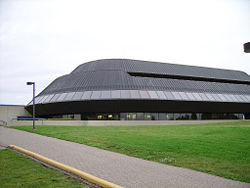
Responsibility and sources
The provincial government of Alberta provides monetary support to 26 post-secondary institutions. (See section: Publicly Funded Post-secondary Institutions) Although Alberta Advanced Education and Technology provides the majority of funding, post-secondary institutions raise additional funds by generating tuition and student fees; offering fee-based services; and offering non-credit and off-campus credit programming. A third source of funding comes from donations, sponsored research funding from provincial and federal agencies and private industry, and investments.In principle the funding of post-secondary education in Alberta is a responsibility shared by students, their families and society. In a context of rising student costs, the Alberta government has set in place policies in areas such as tuition fees and financial assistance to ensure adequate levels of access and affordability.
Tuition fee policy
In order to ensure a reasonable contribution by the students to the costs of post-secondary education, the Alberta government regulates the payment of tuition fees. The tuition fee policy introduced in 1990 and amended in 1995 ensures that this direct monetary contribution does not exceed 30% of the cost of their education.This policy requires public post-secondary institutions to charge the same fee to all residents of Canada and to impose a surcharge of 100% to all foreign students. Although students now contribute proportionately more toward the costs of their post-secondary education than they did in 1994-95, societal contributions have also increased.
Financial assistance
Alberta’s student loan program is structured on the shared-cost principle. Loans are awarded on the basis of student need and parental contributions. Society contributes through loan forgiveness and servicing costs. Alberta’s student financial assistance program has increased student loan levels as well as the number and value of non-repayable forms of financial assistance in a context marked by the rising cost of post-secondary education.Alberta Centennial Education Savings Plan
In 2005 the Alberta Centennial Education Savings Plan (ACES) was created. This program aims to encourage parents to plan early for their children's future post-secondary education needs. ACES pays $500 into a Registered Education Savings PlanRegistered Education Savings Plan
A Registered Education Savings Plan, or RESP, is an investment vehicle used by parents to save for their children's post-secondary education in Canada. The principal advantages of RESPs are the access to the Canada Education Savings Grant and a source of tax-deferred income.-Tax Benefits:An RESP...
for any child born to or adopted by Alberta residents starting 1 January 2005. Additional $100 grants are available at ages 8, 11, and 14 to children enrolled in school, provided at least $100 has been contributed during the previous year.
Research funding
The Ministry of Advanced Education and Technology supports the research function of universities through base operations grants and envelope funding that finance the overall infrastructure required for research in the province. The research infrastructure includes not only physical resources, such as facilities and equipment, but also human resources, such as faculty and graduate students. In addition to the aforementioned mechanisms, a specific type of activity called sponsored research is supported externally by: a) federal research granting councils, b) non-profit, and c) industry sources. However, a significant proportion of this research is sponsored by provincial government sources as well. The allocation of resources for sponsored research is based on the experts’ assessment of the qualities and potential of a particular project.Public Institutions
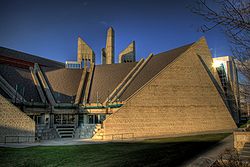
- Athabasca UniversityAthabasca UniversityAthabasca University is a Canadian university in Athabasca, Alberta. It is an accredited research institution which also offers distance education courses and programs. Courses are offered primarily in English with some French offerings. Each year, 32,000 students attend the university. It offers...
- Alberta College of Art and DesignAlberta College of Art and Design-History:The Alberta College of Art & Design is a Canadian degree-granting, publicly-funded art and design college located in Calgary . It was known as the Provincial Institute of Technology and Arts, which was part of SAIT until 1985...
- Banff CentreBanff CentreThe Banff Centre, formerly known as The Banff Centre for Continuing Education, is an arts, cultural, and educational institution and conference complex located in Banff, Alberta...
- Bow Valley CollegeBow Valley CollegeBow Valley College is a public college, with its main campus located in Downtown Calgary, Alberta, Canada. The enabling legislation is the Post-secondary Learning Act The branch campuses are: Airdrie, Banff, Blairmore, Brooks, Canmore, Cardston, Claresholm, Cochrane, Drumheller, Eden Valley, High...
- Grande Prairie Regional CollegeGrande Prairie Regional CollegeGrande Prairie Regional College, often abbreviated GPRC, is a comprehensive community college with two campuses Grande Prairie and Fairview, Alberta. Over 2,000 students in credit programs, and over 6,000 in workforce training and recreational programs, attend GPRC and Fairview College Campus...
- Grant MacEwan University
- Keyano CollegeKeyano CollegeKeyano College is a fully accredited comprehensive community college headquartered in Fort McMurray, in Wood Buffalo region Alberta, Canada which serves post-secondary courses and programs to communities throughout Northern Alberta through both in-classroom and distance education...
- Lakeland CollegeLakeland College (Alberta)Lakeland College is a post-secondary college in Alberta. It is publicly funded, and maintains two campuses in Vermilion and Lloydminster. Lakeland serves about 7,500 full- and part-time students....
- Lethbridge College
- Medicine Hat CollegeMedicine Hat CollegeMedicine Hat College is a public, board governed, comprehensive community college serving a large region of southeastern Alberta and southwestern Saskatchewan, Canada....
- Mount Royal University
- NorQuest CollegeNorQuest CollegeNorQuest College is a publicly-funded community college in Edmonton, Alberta, Canada. The student body numbers over 10,000, with 3,000 full-time and 7,000 part-time students. More than 2,000 students graduate each year.-History:...
- Northern Alberta Institute of TechnologyNorthern Alberta Institute of TechnologyThe Northern Alberta Institute of Technology is located in Edmonton, Alberta, Canada and provides technical training and applied education designed to meet the demands of Alberta's industries...
- Northern Lakes CollegeNorthern Lakes CollegeNorthern Lakes College is a publicly-funded comprehensive community college in north-central Alberta, Canada.Administrative offices are located in Slave Lake and Grouard, Alberta, with a staff of more than 275 working in more than 30 campuses...
- Olds CollegeOlds CollegeOlds College is an Alberta public post-secondary institution located in Olds, Alberta, established in 1913 as Olds Agricultural College. The College opened its first satellite campus in Calgary in 2006 in partnership with the Calgary Stampede Board....
- Portage CollegePortage CollegePortage College is a publicly-funded community college in Lac La Biche, Alberta, Canada.-Mission:Portage College mission is to provide education, training and services to facilitate learning and development of knowledgeable, skilled citizens in a caring, supportive and dynamic college environment...
- Red Deer CollegeRed Deer CollegeRed Deer College is a public comprehensive community college of approximately 7,000 students located in Red Deer, Alberta, Canada. Established in 1964, RDC was built for a smaller semi-rural community but, in the four and a half decades since its founding, the city has grown into the third largest...
- Southern Alberta Institute of TechnologySouthern Alberta Institute of Technology-Academics:SAIT Polytechnic offers two full baccalaureate degrees , four applied degrees, 66 diploma and certificate programs, 32 apprenticeship trades and 1,600 continuing education and corporate training courses....
- University of AlbertaUniversity of AlbertaThe University of Alberta is a public research university located in Edmonton, Alberta, Canada. Founded in 1908 by Alexander Cameron Rutherford, the first premier of Alberta and Henry Marshall Tory, its first president, it is widely recognized as one of the best universities in Canada...
- University of CalgaryUniversity of CalgaryThe University of Calgary is a public research university located in Calgary, Alberta, Canada. Founded in 1966 the U of C is composed of 14 faculties and more than 85 research institutes and centres.More than 25,000 undergraduate and 5,500 graduate students are currently...
- University of LethbridgeUniversity of LethbridgeThe University of Lethbridge is a publicly-funded comprehensive academic and research university, founded in the liberal education tradition, located in Lethbridge, Alberta, Canada, with two other urban campuses in Calgary and Edmonton. The main building sits among the coulees on the west side of...
Independent Institutions
- Ambrose University CollegeAmbrose University CollegeAmbrose University College is a private Christian liberal arts college located in Calgary, Alberta.-History:Ambrose University College is the product of similar educational journeys begun in the first half of the twentieth century....
- Canadian University CollegeCanadian University CollegeCanadian University College is an independent publicly funded university located in Lacombe. It is sponsored by the Seventh-day Adventist Church in Canada and is affiliated with the Association of Theological Schools...
- Concordia University College of AlbertaConcordia University College of AlbertaConcordia University College of Alberta is an Canadian independent university in Edmonton, Alberta. The enabling legislation is the Post-secondary Learning Act.-History:...
- The King's University CollegeKing's University College (Edmonton)The King's University College is a private liberal arts college, located in Edmonton, Alberta, Canada. The University was founded by members of the Christian Reformed Church who saw a need for a regional, trans-denominational, Christian college in Western Canada...
- St. Mary's University CollegeSt. Mary's University College, CalgarySt. Mary's University College is a private Catholic liberal arts institution in the city of Calgary, Alberta, Canada. The college officially became a university college on June 16, 2004, and granted its first degrees on September 25, 2004. The founding Governors were Mr. Justice Frank Quigley,...
Faculty
- Confederation of Alberta Faculty Associations (CAFA)
- Association of Academic Staff University of Alberta (AAS:UA)
- Athabasca University Faculty Association (AUFA)
- The Faculty Association of the University of Calgary (TUCFA)
- University of Lethbridge Faculty Association (ULFA)
Government
- Alberta Apprenticeship and Industry Training Board (AAITB)
- Alberta Council on Admissions and Transfer (ACAT)
- Access Advisory Council
- Alberta Learning Information System (ALIS) Provincial portal for career planning, education and employment information and services provided through a provincial government partnership of Alberta Employment and Immigration, Alberta Education, and Alberta Advanced Education and Technology.
- Campus Alberta Quality Council (CAQC)
- Study in Alberta

